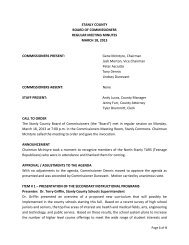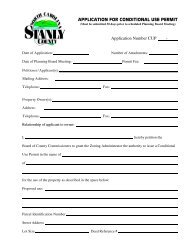Land Use Plan – 2002 - Stanly County, North Carolina
Land Use Plan – 2002 - Stanly County, North Carolina
Land Use Plan – 2002 - Stanly County, North Carolina
You also want an ePaper? Increase the reach of your titles
YUMPU automatically turns print PDFs into web optimized ePapers that Google loves.
Impact fees, and<br />
Adequate public facilities ordinance.<br />
STANLY COUNTY<br />
A description of each of these strategies is described below.<br />
Agricultural Districts<br />
Agricultural districts are voluntary measures that allow farmers and property owners to protect<br />
themselves from nuisance complaints and lawsuits associated with the normal operation of the<br />
farm. This “right to farm” measure allows farmers who agree to enter into a 10-year agricultural<br />
conservation easement between the owner and the county so that non-farming activities are<br />
prohibited for that period. The creation of not more than three lots that meet the planning and<br />
zoning laws of the county are permitted under this measure. Only land that is best suited for<br />
farming (soil conditions, climate, growing season), and actively managed under Soil<br />
Conservation Service erosion practices for highly erodable land may be entered into this<br />
program. The property owner may revoke the agricultural conservation easement at any time.<br />
The <strong>Stanly</strong> <strong>County</strong> Farm Preservation Committee has recently presented a recommendation to<br />
employ the agricultural district in <strong>Stanly</strong> <strong>County</strong> to the <strong>Stanly</strong> <strong>County</strong> <strong>Plan</strong>ning Commission.<br />
Conservation Development<br />
How It Works<br />
Conservation development is a tool and a design process that helps to preserve significant<br />
natural features of a particular site where growth is expected. In this way it is not necessarily<br />
compatible with farmland protection, but more a resource protection mechanism for individual<br />
sites.<br />
By focusing development within the site in areas where there are minimal natural features, other<br />
more significant natural features can be retained. As a result, homes are clustered together in<br />
certain areas which leaves open spaces on the rest of the site. This process allows the existing<br />
underlying densities of the site to be developed, but preserves valuable natural features.<br />
Minimum open space requirements for conservation developments can range up to 60 percent<br />
or higher based on the gross land area of a site. This compares to 20 or 25 percent minimums<br />
for conventional residential subdivisions.<br />
The conservation development model was conceived by planners and designers in the<br />
Connecticut River Valley of western Massachusetts in the late 1980s. Its proponents noted that<br />
large percentages of homebuyers in golf course communities, upwards of 30 percent of the<br />
gross land area, did not necessarily golf, but purchased their home to enjoy the associated open<br />
space of the golf course. Its most famous practitioner is Randall Arendt of the Natural <strong>Land</strong>s<br />
Trust, although a similar program called “The Countryside Program” has been operating<br />
successfully in <strong>North</strong>eastern Ohio since the mid-1990s.<br />
To encourage conservation development, zoning codes must provide the conservation<br />
development model as an option to developers and property owners. Typically conservation<br />
development is encouraged using a basic <strong>Plan</strong>ned Unit Development (PUD) ordinance as a<br />
foundation.<br />
After an ordinance is adopted outlining the principles, the design process begins. The design<br />
process involves four major steps:<br />
<strong>Land</strong> <strong>Use</strong> <strong>Plan</strong> 6-16 6/02






